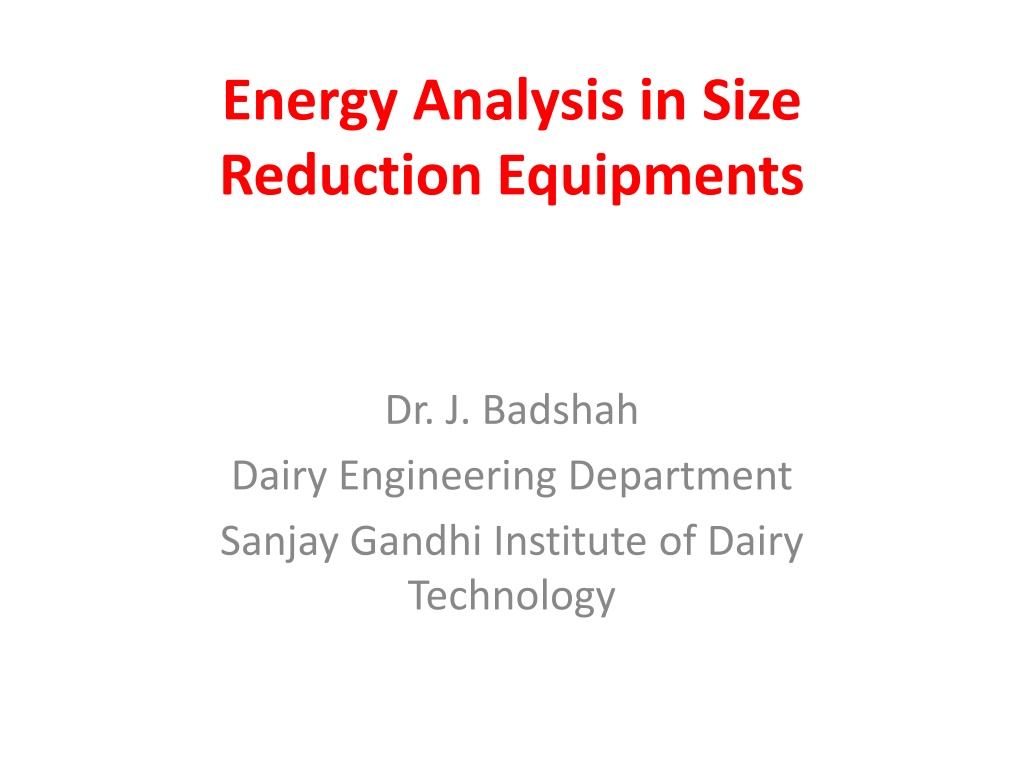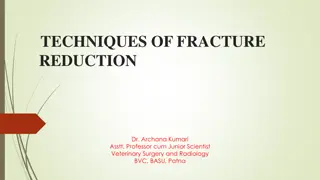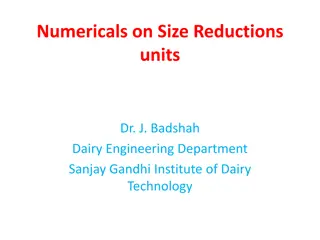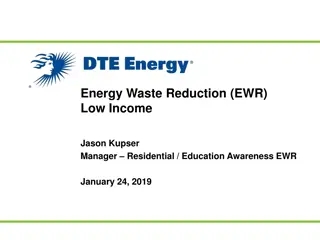Understanding Energy Analysis in Size Reduction Equipments
This comprehensive overview delves into the energy analysis involved in size reduction equipment, exploring topics such as objectives of size reduction units, sieve analysis for particle size distribution, mesh number system, and mathematical models for energy analysis in size reduction units. Dr. J. Badshah from the Dairy Engineering Department at the Sanjay Gandhi Institute of Dairy Technology has provided valuable insights into enhancing extraction rates, developing new products, and increasing surface area while reducing process times. The content emphasizes the importance of energy efficiency in various size reduction processes.
- Energy Analysis
- Size Reduction Equipments
- Particle Size Distribution
- Sieve Analysis
- Dairy Engineering
Download Presentation

Please find below an Image/Link to download the presentation.
The content on the website is provided AS IS for your information and personal use only. It may not be sold, licensed, or shared on other websites without obtaining consent from the author. Download presentation by click this link. If you encounter any issues during the download, it is possible that the publisher has removed the file from their server.
E N D
Presentation Transcript
Energy Analysis in Size Reduction Equipments Dr. J. Badshah Dairy Engineering Department Sanjay Gandhi Institute of Dairy Technology
Objectives of Size Reduction Units Enhanced Rate of extraction &expresion of juices Development of new products such as flour, maida, spices, etc. Size High rate of drying, freezing, crystallizati on etc. reduction causing Increase in surface Area Reduction in Process Time in Cooking, Blanching
Sieve Analysis Particle size distribution in granular materials : Sieving or screening Classification in course, medium and fine grains Uniformity Index= Course : Medium : Fine grains If it is 1: 3 : 6, then Course grain = 1/10, edium = 3/10 and Fine grains = 6/10 Fineness Modulus: Defined as the sum of the percent weight fraction retained above each sieve divided by 100. Average size of particles in inches = Dp= 0.0041 (2) F.M. Average Size of Particles in mm, Dp= 0.135 (1.366)F.M.
Sieve Stack arranged in increasing order of mesh size 7 3/8 Mesh weight fraction% w1 6 4 Mesh w2 5 8 w3 F.M. = (w1x7+ w2x6+ w3 x5 4 14 w4 +w4x4+ w5x3+ w6 x2 3 28 w5 2 48 w6 1 100 w7 0 Pan w8 w7x1+ w8 x0 )/100
Mesh Number System The mesh number system is a measure of how many openings there are as per linear inch in a screen. Sieving is a method of separating a mixture or grains into two or more size fractions. The oversize materials are trapped above the screen, while undersize materials can pass though the screen. In stacks, sieve divides samples into various size fractions. There are two mesh sizes 9I) US Sieve size and Tyler equivalent size or Tyler Mesh Size. Table is available for ex. 10 Us sieve = 9 Tyler mesh = 2 mm, 40 US Sieve = 35 Tyler mesh = 0.420 mm and 100 US sieve = 100 Tyler Mesh = 0.149 mm particle size opening eyc.
Energy Analysis of Size Reduction Unit Mathematical Models for energy dE required to produce small change dx in the size of a unit mass of material i. General Model : dE/dx = - K /xn Rittinger s Law: i. Energy required is proportional to the new surface area produced, i.e. n=2 ii. dE/dx= - K /x2 iii. On Integration E = KR[1/x2 1/x1] iv. x1and x2 are the average size of feed and product particles v. E is the energy per unit mass required to produce this increase in surface area and KR is Rittinger s constant vi. It is found to hold better for fine grinding where greater change in surface area is required.
Energy Analysis of Size Reduction Unit Kick s Law: i. ii. iii. iv. v. Energy required is proportional to size reduction ratio i.e. n=1 dE/dx= - K /x1 dE = - K /x for limit x1 to x2 On Integration E = Kkln (x1 / x2 ) x1and x2 are the average size of feed and product particles E is the energy per unit mass required to produce this increase in size and Kkis Kicks constant Kick s law has been found to apply best to coarse crushing Bond s Law: i. Energy required is proportional to the square root of the surface to volume ratio of the product and n = 3/2 ii. dE/dx= - K /x3/2 dE = - K /x3/2for limit x1 to x2 iii. On Integration E = 2 KB[ 1/ x2- 1/ x1] iv. x1and x2 are the average size of feed and product particles v. E is the energy per unit mass required to produce this increase in size and KBis Bonds constant vi. Bond s law has been found to apply best to variety of materials undergoing coarse, intermediate and fine grinding vi.
Bondslaw in terms of Bond Work Index Energy Required in KW hr per unit mass in ton Ranges from 10 -20 KWhr/ton Dpand Dfare size such that 80 % of the sample passed through mesh of diameter Dpand Dfin mm respectively. Wi Bond work index in required to reduce from a very size to that size in which 80% passing through the 100 micron screen P= kilowatt and m = ton/ hr Kb = (100x10-3) wi= 0.3162 wi P/m= 0.3162 wi[1/ Dp- 1/ Df] (2000 lb) is the work
Numericals on Bonds law What is the power required to crush 100 tons /hr of limestone if 80 per cent of the feed passes a 2 in screen and 80% of the product a 1/8 in screen? Given index for limestone is 12.74 Solution: M = 100 tons /hr Dpa= 2 inch = 2x 25.4 = 50.8 mm Dpb= 1/8 inch = 1/8x 25.4 = 3.175 mm The Power Required P/m = 0.3162 wi[1/ Dp- 1/ Df] Therefore, P = 100 x 0.3162 x12.74 (1/ 3.175 1/ 50.8) Therefore P = 169.6 KW = 227 hp
Numericals on Bonds Law Sugar is ground from crystal of which 80% pass 30 mesh screen down to a size in which 80% pass a 200 mesh sieve and 5 h.p. metor is sufficient for required throughput. If the requirement is changed grounding is only down to 80% through a 150 mesh sieve but the throughput is to be increased by 80%. Would the existing motor has the sufficient power to operate the grinder. Assume Bond Equation. such that the
Numericals on Bonds Law Df= 30 mesh = 0.595 mm Dp1 = 200 mesh = 0.074 mm Dp2 = 150 mesh = 0.110 mm M1 = m M2 = 1.8 m P1 = 5 h.p. = 5 x 0.746 = 3.730 Kw Using Bonds Law The Power Required P/m = 0.3162 wi[1/ Dp- 1/ Df] 3.73/m = 0.3162 wi[1/ 0.074 - 1/ 0.595 ] ---------(1) Similarly P2/ 1.8 m = 0.3162 Wi [ 1/ 0.110 - 1/ 0.595 ]----(2) On solution P2 = 6.55 h.p. ( Not Sufficient)























